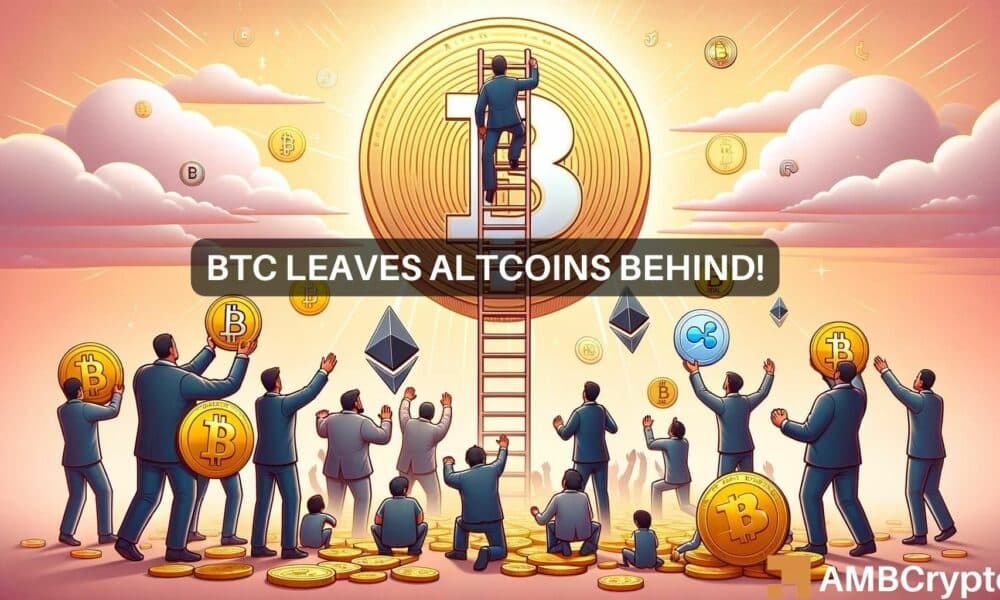- The altcoin market has remained bearish, with no significant growth triggers.
- Analysts suggest a potential recovery only after Bitcoin reaches a $100,000 milestone.
The cryptocurrency market has witnessed a substantial downturn in the altcoin sector, which has struggled to gain momentum amid a broader market focus on Bitcoin. [BTC].
In recent weeks, the altcoin market cap has seen a significant decline from its late May peak of $1.182 trillion to a current valuation of just over $1.06 trillion.
This shift reflects a broader sense of caution and bearish momentum that appears to be in line with a lack of substantive new stories driving investor interest compared to previous cycles, according to analyst Crypto Ash.
Bitcoin is waiting for $100,000
Crypto As pointed out that the long-awaited ‘Mega Altseason’ remains elusive as the total market capitalization of altcoins has fallen to levels not seen since December 2023.
Current market conditions do not show significant drivers comparable to the innovations of previous years, leaving the altcoin sector in a state of uncertainty.
According to Crypto Ash, the potential for significant altcoin rallies depends on Bitcoin’s performance, suggesting that a real altcoin season won’t begin until Bitcoin reaches the $100,000 milestone price.
In the meantime, he advised that this period could be ideal for accumulating undervalued utility-based tokens.
He highlighted that while retail interest remains subdued, smart investors and whales are actively positioning themselves during this downturn, indicating a strategic build-up in anticipation of future gains.
Meanwhile, Crypto Distilled, another crypto analyst, has made an offer insights to the conditions necessary for an altcoin rebound.
He emphasized the importance of liquidity, especially of stablecoins such as Tether [USDT]which are essential for altcoin liquidity on decentralized exchanges (DEXs).

Source: X/Crypto Distilled
He noted that USDT growth has been minimal since February 11, and that a revival of stablecoin liquidity is critical for sustainable price appreciation in altcoins.
Furthermore, Crypto Distilled proposed to monitor the Smart Contract Platforms index, as these platforms are essential for decentralized applications (dApps) and significantly influence market trends.
The presence of Layer 1 governance tokens adds liquidity to their ecosystems and the possible introduction of an Ethereum [ETH] ETF could be an important liquidity driver.
He revealed that JamieCoutts, a lead crypto analyst, has highlighted two crucial indicators to watch: an uptrend in the Smart Contract Platforms (SCP) sector and a rise in the Altseason Index.
Historically, an alignment of these trends has signaled significant gains for altcoins, sometimes more than tenfold.
In its final thoughts, Crypto Distilled drew parallels to the last market cycle, which saw Bitcoin react strongly to post-COVID liquidity shifts.
He noted that in the current environment of global uncertainty, liquidity growth is not meeting expectations. So this cycle could see a focus on Bitcoin, with altcoin catalysts playing a background role.
Market dynamics and investor behavior
The performance difference between Bitcoin and altcoins is large. As Bitcoin approaches its all-time high, altcoins are crashing and mimicking bear market conditions.
This difference is especially evident in the performance metrics of leading altcoins like XRP, which have seen a decline of almost 10% in recent weeks.
Further, facts van Santiment highlighted a significant drop in the number of active XRP addresses, indicating declining user engagement and possibly portending further price declines.

Source: Santiment
Despite the recession, there is a bright spot, as AMBCrypto reported increase in the number of XRP holders increased by 100,000 in early June, indicating underlying yields despite prevailing market challenges.
Read Bitcoin’s [BTC] Price forecast 2024-2025
This complex landscape suggests that the altcoin market is facing near-term headwinds.
However, the foundation for future rallies could be forming behind the scenes as investors recalibrate their strategies in response to changing market dynamics.

